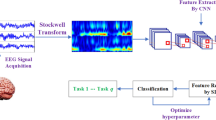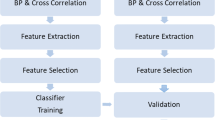Abstract
Functional near-infrared (fNIR)-based motor imagery (MI) classification is an interesting challenge for the brain–computer interface (BCI) implementation. The success of the fNIR-BCI mostly depends on the classification performance. Usually, machine learning-based complex algorithms are used to classify the fNIR-MI data which often proves impractical to program in small hardware. Therefore, the practical small and low price hardware-based BCI system demands simple algorithm that can provide satisfactory classification accuracy. This paper proposes an fNIR-MI data classifier utilizing the multiple linear regression model (MLRM). In this work, two-class fNIR-MI data were acquired for feature extraction and classification. The predictive model for classification was prepared by the proposed method. Additionally, the same dataset was classified by the widely used classification method—support vector machine (SVM) and linear discriminant analysis (LDA). The results reveal that the proposed multiple linear regression model-based classifier (MLRMC) shows almost equivalent results compared to the SVM and LDA on the same features, although MLRM is a much simpler algorithm than that of the others. Therefore, the outcomes of this research work claim that the proposed MLRMC is a good choice as a classifier for fNIR-like simple signal classification.









Similar content being viewed by others
References
Ranganatha, S., Hoshi, Y., Guan, C.: Near infrared spectroscopy based brain–computer interface. SPIE. Soc. Opt. Eng. Proc. SPIE 5852, 434–442 (2005). https://doi.org/10.1117/12.621536
Naseer, N., Qureshi, N.K., Noori, F.M., Hong, K.S.: Analysis of different classification techniques for two-class functional near-infrared spectroscopy-based brain–computer interface. Comput. Intell. Neurosci. 1–11, 2016 (2016). https://doi.org/10.1155/2016/5480760
Nicolas-Alonso, L.F., Gomez-Gil, J.: Brain computer interfaces, a review. Sensors 12(2), 1211–1279 (2012). https://doi.org/10.3390/s120201211
Abibullaev, B., An, J.: Classification of frontal cortex haemodynamic responses during cognitive tasks using wavelet transforms and machine learning algorithms. Med. Eng. Phys. 34(10), 1394–1410 (2012). https://doi.org/10.1016/j.medengphy.2012.01.002
Holper, L., Wolf, M.: Single-trial classification of motor imagery differing in task complexity: a functional near-infrared spectroscopy study. J. NeuroEng. Rehabil. 8(1), 1–13 (2011). https://doi.org/10.1186/1743-0003-8-34
Hong, K.S., Naseer, N., Kim, Y.: Classification of prefrontal and motor cortex signals for three-class fNIRS-BCI. Neurosci. Lett. 587, 87–92 (2015). https://doi.org/10.1016/j.neulet.2014.12.029
Naseer, N., Noori, F.M., Qureshi, N.K., Hong, K.S.: Determining optimal feature-combination for LDA classification of functional near-infrared spectroscopy signals in brain–computer interface application. Front. Human Neurosci. 10, 1–10 (2016). https://doi.org/10.3389/fnhum.2016.00237
M.A. Rahman, F. Khanam, M. Ahmad, Detection of effective temporal window for classification of motor imagery events from prefrontal hemodynamics. In: 2019 International Conference on Electrical, Computer and Communication Engineering (ECCE) (2019). https://doi.org/10.1109/ECACE.2019.8679317
N.K. Qureshi, F.M. Noori, A. Abdullah, N. Naseer, Comparison of classification performance for fNIRS-BCI system. In: International Conference on Robotics and Artificial Intelligence (ICRAI), Rawalpindi, pp. 54–57 (2016). https://doi.org/10.1109/ICRAI.2016.7791228
M.A. Rahman, M.M. Milu, A. Anjum, M.N. Mollah, M. Ahmed, Classification of motor imagery events from prefrontal hemodynamics for BCI application. In: International Joint Conference on Computational Intelligence (IJCCI 2018), At Dhaka, Bangldesh. Springer Nature, pp.11–23 (2018). https://doi.org/10.1007/978-981-13-7564-4_2
Shin, J., Jeong, J.: Multiclass classification of hemodynamic responses for performance improvement of functional near-infrared spectroscopy-based brain–computer interface. J. Biomed. Opt. 19(6), 067009 (2014). https://doi.org/10.1117/1.JBO.19.6.067009
Hai, N.T., Cuong, N.Q., Khoa, T.Q.D., Vo, T.V.: Temporal hemodynamic classification of two hands tapping using functional near—infrared spectroscopy. Front. Human Neurosci. 7(September), 1–12 (2013). https://doi.org/10.3389/fnhum.2013.00516
Janani, A., Sasikala, M.: Classification of fNIRS signals for decoding right- and left-arm movement execution using SVM for BCI applications. Computational Signal Processing and Analysis. Lecture Notes in Electrical Engineering, vol 490. Springer, Berlin (2018). https://doi.org/10.1007/978-981-10-8354-9_29
V. Gottemukkula, R. Derakhshani, Classification-guided feature selection for NIRS-based BCI. In: 2011 5th International IEEE/EMBS Conference on Neural Engineering (2011). https://doi.org/10.1109/NER.2011.5910491
Trakoolwilaiwan, T., Behboodi, B., Lee, J., Kim, K., Choi, J.W.: Convolutional neural network for high-accuracy functional near-infrared spectroscopy in a brain–computer interface. Neurophotonics 5, 1 (2017). https://doi.org/10.1117/1.NPh.5.1.011008
B. Xu, Y.Fu , L. Miao, Z. Wang, H. Li, Classification of fNIRS data using wavelets and support vector machine during speed and force imagination. In: International Conference on Robotics and Biomimetics, ROBIO (2011). https://doi.org/10.1109/ROBIO.2011.6181455
Sitaram, R., Zhang, H., Guan, C., Thulasidas, M., Hoshi, Y., Ishikawa, A., Shimizu, K., Birbaumerb, N.: Temporal classification of multichannel near-infrared spectroscopy signals of motor imagery for developing a brain–computer interface. NeuroImage 34(4), 1416–1427 (2007). https://doi.org/10.1016/j.neuroimage.2006.11.005
Power, S.D., Falk, T.H., Chau, T.: Classification of prefrontal activity due to mental arithmetic and music imagery using hidden Markov models and frequency domain near-infrared spectroscopy. J. Neural Eng. 7, 2 (2010). https://doi.org/10.1088/1741-2560/7/2/026002
T. Kitamura, N. Tsujiuchi, T. Koizumi, Hand motion estimation by EMG signals using linear multiple regression models. In: International Conference of the IEEE Engineering in Medicine and Biology Society, New York, NY, pp. 1339–1342 (2006). https://doi.org/10.1109/IEMBS.2006.259329
F.T. Zohra, A.D. Gavrilov, O.Z. Duran, M. Gavrilova, A linear regression model for estimating facial image quality. In: International Conference on Cognitive Informatics and Cognitive Computing (ICCI*CC), Oxford, pp. 130–138 (2017). https://doi.org/10.1109/ICCI-CC.2017.8109741
H. Wang, F. Hao, An efficient linear regression classifier. In: 2012 IEEE International Conference on Signal Processing, Computing and Control, ISPCC (2012). https://doi.org/10.1109/ISPCC.2012.6224355
M.A. Rahman, M. Ahmad, A straight forward signal processing scheme to improve effect size of fNIR signals. In: 5th International Conference on Informatics, Electronics and Vision, ICIEV 2016, Dhaka University, Dhaka, Bangladesh (2016). https://doi.org/10.1109/ICIEV.2016.7760042
Rahman, M.A., Hossain, M.K., Khanam, F., Alam, M.K., Ahmad, M.: Four-class motor imagery EEG signal classification using PCA, wavelet, and two-stage neural network. Int. J. Adv. Comput. Sci. Appl. 10, 5 (2019). https://doi.org/10.14569/IJACSA.2019.0100562
Rahman, M.A., Rashid, M.A., Ahmad, M.: Selecting the optimal conditions of Savitzky–Golay filter for fNIRS signal. Biocybern. Biomed. Eng. 39(3), 624–637 (2019). https://doi.org/10.1016/j.bbe.2019.06.004
M. A. Rahman, M. Ahmad, Lie detection from single feature of functional near infrared spectroscopic (fNIRS) Signals. In: 2nd International Conference on Electrical and Electronic Engineering (ICEEE 2017), 27–29 December, Rajshahi University of Engineering and Technology (RUET), Rajshahi, Bangladesh. https://doi.org/10.1109/CEEE.2017.8412900
Rahman, M.A., Uddin, M.S., Ahmad, M.: Modeling and classification of voluntary and imagery movements for brain–computer interface from fNIR and EEG signals through convolutional neural network. Health Inform. Sci. Syst. 7, 1 (2019). https://doi.org/10.1007/s13755-019-0081-5
Trakoolwilaiwan, T., Behboodi, B., Lee, J., Kim, K., Choi, J.: Convolutional neural network for high-accuracy functional near-infrared spectroscopy in a brain–computer interface: three-class classification of rest, right-, and left-hand motor execution. Neurophotonics (2018). https://doi.org/10.1117/1.NPh.5.1.011008
Hiwa, S., Hanawa, K., Tamura, R., Hachisuka, K., Hiroyasu, T.: Analyzing brain functions by subject classification of functional near-infrared spectroscopy data using convolutional neural networks analysis. Comput. Intell. Neurosci. (2016). https://doi.org/10.1155/2016/1841945
G. Huve, K. Takahashi, M. Hashimoto, fNIRS-based brain–computer interface using deep neural networks for classifying the mental state of drivers. In: International Conference on Artificial Neural Networks (ICANN), 2018, Lecture Notes in Computer Science, vol. 11141. Springer, Cham. https://doi.org/10.1007/978-3-030-01424-7_35
Chiarelli, A.M., Croce, P., Merla, A., Zappasodi, F.: Deep learning for hybrid EEG-fNIRS brain–computer interface: application to motor imagery classification. J. Neural Eng. 15, 3 (2018). https://doi.org/10.1088/1741-2552/aaaf82
Funding
No third party or organization provided funds for this research so far.
Author information
Authors and Affiliations
Corresponding author
Ethics declarations
Conflict of interest
The authors declare no conflict of interest regarding this research work.
Additional information
Publisher's Note
Springer Nature remains neutral with regard to jurisdictional claims in published maps and institutional affiliations.
Rights and permissions
About this article
Cite this article
Galib, S.M.S., Islam, S.M.R. & Rahman, M.A. A multiple linear regression model approach for two-class fNIR data classification. Iran J Comput Sci 4, 45–58 (2021). https://doi.org/10.1007/s42044-020-00064-0
Received:
Accepted:
Published:
Issue Date:
DOI: https://doi.org/10.1007/s42044-020-00064-0




